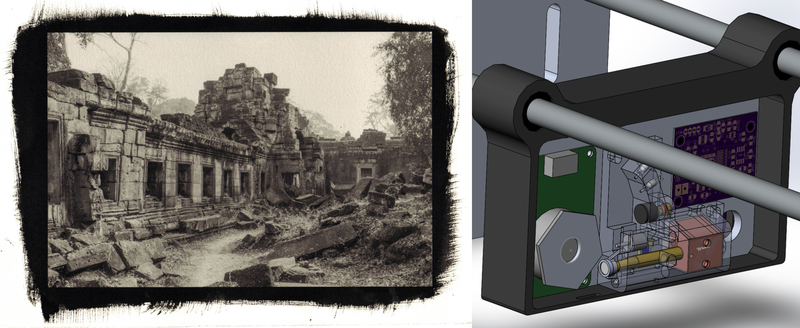There is a family of old photographic chemistries based on iron compounds which, like the blueprint, are exposed using UV light. Ironically, the digital camera revolution which has made everything else in our photographic lives much easier, has made it harder to experiment around with these alternative methods. [David Brown] is making a UV photographic printer to change that.
[David]’s application has a lot in common with PCB printers that use a UV-sensitive resist, only [David] needs greyscale, and it might also be nice if it could work with wet paper. This makes it a more challenging project than you might think, but we like the cut of [David]’s jib.
Like some of the other UV exposer projects, [David]’s uses a rotating mirror to scan across the to-be photograph’s surface. Unlike the other ones that we’ve seen, the exposer hangs from two linear rails. Other printers move the paper underneath a stationary scanning head, which seems a mechanically simpler arrangement. We’re excited to see how this goes.
There’s a lot of interest in UV PCB printers right now. We’ve seen one made from junked CD-ROM drives on one end of the spectrum to one made by retrofitting a delta robot on the other. And don’t disregard the work done by folks interested in UV-curing 3D printers, either.
















why not use a laserprinter and make a fake toner unit where the paper goes?
From the project page:
The design aim is to achieve minimum of;
– 256 levels exposure, minimum
– greater than 750 dpi resolution
– bed width of ~500mm, to accommodate reasonable sized prints
Those sound like specs exceeding consumer grade laser printers, especially in the exposure levels.
The OP has more/other in mind, but that’s actually a brilliant idea if the printer is shooting out UV. What type of laser is in there, anyway?
Pretty much any $5 blue laserpointer on DX :-D
I don’t know if you could get the required resolution with that range of intensities.
The laser printer has an octagonal nut shaped mirror that scans the beam across the page (8 times per rotation). It is driven by a brushless motor that has a very small number of phases per rotation using quite complex drive circuitry. As a result of this configuration, it not possible to get beam sync from the motor so instead laser printers have a laser sensor that is directed back towards the mirror but in a position that co-responds to just off the left or the right of the page so it doesn’t interfere with the print. The pulses to the laser diode are timed to be a certain time after the sync.
The laser drum process is more or less binary in that the toner either sticks or it doesn’t stick. So it operates through a threshold rather than across a range of intensities. It is easy to design circuitry that can very quickly flip a laser back and forth across that threshold but I would expect it to be quite complex to have the whole system work with variable analog intensities.
All the same it should be doable and a Laser projection assembly from a laser printer could be attached to a stepper driven axis. or have the stepper drive the screen.
I would love to be able to do double sided PCB’s this way as this is also a binary thing but with a need for a higher transition hysteresis.
What about using a DLP projector with a UV light in it to expose the print? Take out the colour wheel, have a bright enough UV light and in theory is should work (just wear sunglasses and don’t stand in front of the damn thing if you don’t want a sunburn.)
The simplest mechanism would be the inverse of a drum scanner where the paper is on the drum and the imaging head just moves along a single screw so that the path on the drum is a helix. Obviously there is a small amount of maths required to match the path to the Cartesian coordinates of the image or you will end up with a small amount of skew proportional to the print’s width relative to the drum circumference. You could probably do this on a large scale by hacking a lathe. Doing the exposure in two passes with right and left hand helix may improve the end result.
These prints need a wet medium.
At speed a drum scanner will spin the chemistries off the paper.
At slower speed, the paper would probably dry out before completing exposure
Invert the geometry a bit, think about it, how many sides are there on a drum? :-)
:-)
Is that a photo of Ta Prohm or other nearby temple?